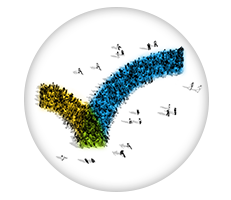Personalized B2B marketing is picking up steam and has become standard B2B practice. With the consumerization of B2B marketing, B2B buyers now expect brands to personalize even their early interactions. In the recent Winterberry Group research study, 51% of marketers recognized that personalization is becoming more important in content and media consumption for B2B customers.
Building your marketing strategy to incorporate personalization at scale once seemed like an impossible task, but now with artificial intelligence (AI) and machine learning (ML) digital marketing leaders can support personalized engagement for customer acquisition and retention across their efforts.
AI for personalized B2B marketing: 3 ways to start
Personalization has become a staple of successful B2B campaigns because B2B buyers expect it. That being said, you should engage based on something you know the person cares about. Otherwise, you don’t get their attention.
Personalization is expected and that puts pressure on marketers to deliver meaningful experiences. The data is there to do it; how to activate it is the game changer. Artificial intelligence shows marketers relevant ways to put data to work. While personalization using AI has been tried and proven, only a small portion of the B2B community feels confident with the technique. That needs to change.
Not sure where to start? Try these 3 ways to use AI for B2B marketing personalization at scale:
- Capture data with chatbots: Going a step beyond the contact form, AI chatbots deliver customized conversation flows to best engage prospects. These chatbots capture data effectively that you can then feed into your CRM for insights to create personalized communications.
- Simplify customer segmentation: AI can identify prospects and segment them based on behavioral patterns, industry, roles, and more. With AI, you can more easily communicate with groups of customers who share similar traits, goals, and preferences.
- Send messages to prospects at the right time: AI can be used to determine when a prospect like yours is most likely to open messages by analyzing different metrics like reading time and click-through rates. With these insights, you can reach out with relevant messages at the right time and create more personalized B2B marketing experiences.
Intent data and conversational landing pages: Helping B2B brands with personalization at scale
The internet has become saturated with B2B companies promoting content, and marketers know relevant content breaks through the clutter, but personalization at scale? It sounds challenging, but there are several solutions that use AI and ML in different ways to make it possible for your company.
Intent data providers, like Anteriad, and AI chatbots, like Drift, use artificial intelligence and machine learning to collect information about in-market prospects and engage around their needs. For Anteriad, the end goal is to gather intent intelligence; for these chatbots, it’s conversational marketing.
These technologies drive personalization in a similar way – both get at the prospect’s intent. We’re all familiar with the instant, automated yet personalized experience of a good chatbot. “What brought you to our site today?” is how the chatbot engages with each website visitor. Intent data looks at online buyer behavior and turns it into relevant, personalized campaigns to engage prospects.
Many chatbots have deep integrations with sales and marketing platforms. Similarly, Anteriad’s intent data can be delivered through integrations with marketing automation and CRM. Both approaches help brands get their messages and information to people who will benefit from them and do it at scale.
Bot-enabled website landing pages are an effective, low-risk way to stand apart from the competition with true, personalized engagement. Conversational landing pages use chatbot software to engage visitors while they’re live on your page – where you want them. These website visitors represent your most engaged customers and prospects. Instead of asking for form fills, and then following up, brands can have personalized conversations in the moment. It’s a faster path through the pipeline.
It’s more important than ever to deliver exceptional, personalized customer experiences all the time across all the channels, throughout the buyer lifecycle.
Data-driven B2B Marketing: Personalize Customer Experience
Staying ahead of your competitors to deliver the best experience starts with understanding buyers’ needs and pain points. Many teams have found that a data-driven marketing approach is a reliable solution for personalization at scale. Use data-driven marketing for better customer experience (CX).
The sooner you adopt a data-driven approach, the more effective you’ll be. Data obtained across journey touch points on websites or apps, from the first interaction to the final conversion, educate marketers about buyer behavior at each touchpoint. A strategy based on data-driven marketing allows you to collect useful information so you can be more agile and personalized in your communications to prospects. Gathering relevant data from prospects and customers, then analyzing it provides insights into improving your customer experience across the entire buying journey. You can use the insights for a range of outcomes from improving your content based on buyer engagement analytics to making your brand identity more diverse based on demographic data.
Be careful of over-personalization
With everything that’s been said about the need for personalization, it seems crazy to even mention over-personalization. This seems counterintuitive. Afterall, a main benefit of AI for B2B content personalization is that it removes the guesswork. But it’s important to remember that AI still requires a human touch.
The degree of personalization AI brings to B2B lead generation is almost limitless, via segmentation, targeting or on-the-fly customization. But with AI’s ability to personalize content so precisely also comes the risk of over-personalizing customers’ content experience. Since AI has the capability to track troves of data efficiently and effectively, it’s important to take a step back and look at the full picture. What data does it actually make sense for you to personalize? You want your messages to come across as personal and intentional, but not cross that thin line into intrusive and creepy.
AI never stops learning. With AI, you no longer need to assume anything about your prospects. You can more closely tailor lead generation to their individual preferences and likely responses. Highly personalized creative in support of a single product or channel improves ROI. But there’s a chance it can also limit your opportunities for cross-sell or upsell of new products and services that the user might be interested in. The takeaway here is: It’s all about balance. Understanding where your customer is in their buying journey can help you navigate when personalization makes sense and when you are able to give them a broader view of your offerings.
Content personalization at scale: Yes, it’s worth it
Impactful content personalization does take time, effort, and resources to achieve, but the positive outcomes of higher engagement and conversions are well worth it. When you’re starting out with personalization, it can be helpful to start with a smaller pilot program. You’ll need to take data hygiene seriously to make sure you don’t run into any issues in personalization. Incorrect personalization will only cause a poor brand experience and do the opposite of what you’ve set out to do with personalization. Once you have a proven process in place scale up your personalization to maximize your efforts.


